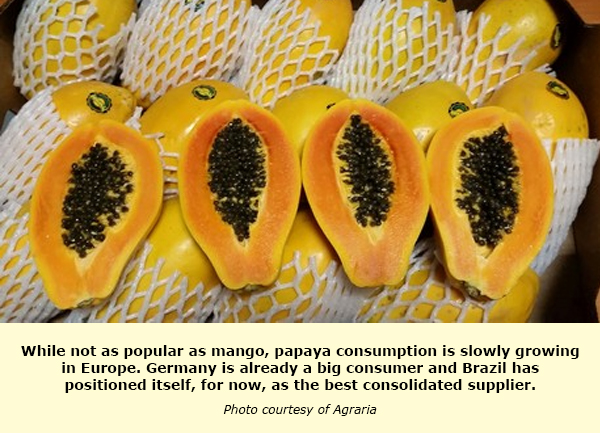In Europe, papaya consumption isn’t yet as common as in tropical countries, but it is growing gradually.
A report from the Center for the Promotion of Imports from Developing Countries (CBI), gave those exporting papayas to the Old Continent a list of the qualities they should strive for in their products. They should be clean, pesticide-free, without abnormal external moisture, odorless, with a firm texture, without signs of damage by high or low temperatures and with a stem that doesn’t exceed 1 centimeter in length.
It is acknowledged that papayas are difficult to handle due to the fruit’s relatively short shelf life and delicacy, since the fruit is easily bruised.

Growing market
The CBI points out that after several years in which the European import of papayas remained at 30 thousand tons, the figure grew to 40 thousand tons in 2015 and 2016. Already in 2017 the volume reached 43 thousand tons worth 103 million Euro. “This shows that more and more consumers are becoming familiar with papayas. Virtually all papaya imports arriving in Europe come from developing countries,” he says.
The entity explains that Germany and the Netherlands are the main importers of fresh papayas, and they are also the ones recording the highest growth levels. A good part of the German imports are made through the Netherlands (70% of the papayas that enter this country are re-exported), which explains the high figures of both countries. Portugal and Spain also import large quantities. In the former’s case, it is due to its historical ties with Brazil, the largest exporter of papayas. However, the volumes are still low in the countries of Eastern Europe.
In order to try exporting papayas to the European continent, the commercial promotion institution recommends looking for varieties and technical improvements that facilitate the transport of this delicate fruit. A good example is the Original Brazilian papaya, which has a longer shelf life and greater resistance to diseases. Gaining experience in papaya ripening at destination will also help stimulate the demand for ready-to-eat presentations.
The main varieties in the European market are currently the Sunrise and Golden Solo for small sizes of up to 700 grams, and the Formosa for those that exceed one kilo. Consumers tend to prefer the smaller ones, especially in north-western Europe.
There are also opportunities in the organic papayas.
Source: Agraria
Translation: Freshplaza
